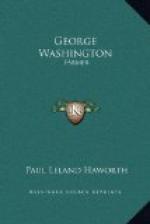[Illustration: One of Washington’s Tavern Bills]
His sideboard and table were well equipped with glasses and silver wine coolers of the most expensive construction. As in many other matters, his inventive bent turned in this direction. Having noticed the confusion that often arose from the passing of the bottles about the table he designed when President a sort of silver caster capable of holding four bottles. They were used with great success on state occasions and were so convenient that other people adopted the invention, so that wine coasters, after the Washington design, became a part of the furniture of every fashionable sideboard.
To cool wine, meat and other articles, Washington early adopted the practice of putting up ice, a thing then unusual. In January, 1785, he prepared a dry well under the summer house and also one in his new cellar and in due time had both filled. June fifth he “Opened the well in my Cellar in which I had laid up a store of Ice, but there was not the smallest particle remaining.—I then opened the other Repository (call the dry Well) in which I found a large store.” Later he erected an ice house to the eastward of the flower garden.
His experience with the cellar well was hardly less successful than that of his friend, James Madison, on a like occasion. Madison had an ice house filled with ice, and a skeptical overseer wagered a turkey against a mint julep that by the fourth of July the ice would all have disappeared. The day came, they opened the house, and behold there was enough ice for exactly one julep! Truly a sad situation when there were two Virginia gentlemen.
Mention of Madison in this connection calls to mind the popular notion that it was his wife Dolly who invented ice-cream. I believe that her biographers claim for her the credit of the discovery. The role of the iconoclast is a thankless one and I confess to a liking for Dolly, but I have discovered in Washington’s cash memorandum book under date of May 17, 1784, the entry: “By a Cream Machine for Ice,” L1.13.4—that is an ice-cream freezer. The immortal Dolly was then not quite twelve years old.
Washington seems to have owned three coaches. The first he ordered in London in 1758 in preparation for his marriage. It was to be fashionable, genteel and of seasoned wood; the body preferably green, with a light gilding on the mouldings, with other suitable ornaments including the Washington arms. It was sent with high recommendations, but proved to be of badly seasoned material, so that the panels shrunk and slipped out of the mouldings within two months and split from end to end, much to his disgust. Such a chariot was driven not with lines from a driver’s box, but by liveried postillions riding on horseback, one horseman to each span.




